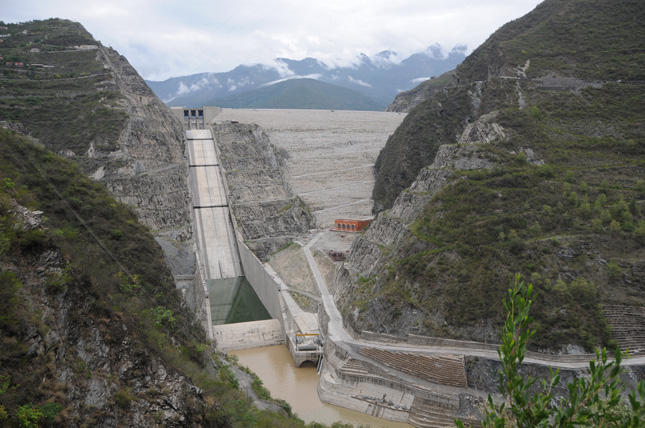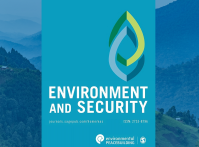-
Water-Energy Nexus in the Himalayas

The region at the base of the Himalayas faces difficult tradeoffs when allocating freshwater resources for energy production versus agricultural, industrial, and domestic uses. This is one of the most ecologically unstable areas on Earth, and weather patterns are becoming increasingly irregular. On one end of the spectrum, water shortages frequently disrupt energy production, which depends largely on water-intensive coal and hydropower plants. The opposite extreme is also a factor: Dozens of hydropower plants in the Himalayas have been damaged or destroyed by severe floods caused by unusually heavy rainfall in recent years. Construction of new power plants faces increasing resistance from local communities, resulting in social disruptions and instability. In order to ensure both energy security and water security for their countries, governments must look beyond hydropower and coal.
Ecological Challenges
Pakistan and India are among the countries with the world’s highest climate risk, ranking fifth and tenth, respectively, in the 2016 Germanwatch Global Climate Risk Index. Climate extremes on both ends of the rainfall spectrum threaten this region, and weather patterns are becoming increasingly unpredictable. In both 2015 and 2016, record-setting floods killed thousands of people, destroyed tens of thousands of homes, and damaged hydropower facilities.
In the months between these two floods, other parts of India experienced the worst drought in 69 years. This extreme drought was part of an ongoing trend: India saw only 10 droughts in the nearly 40 years between 1950 and 1989, but has already experienced five droughts between 2000 and 2016. This frequency is expected to increase. Water supply in the Indus River Basin is dwindling. Parts of the Ganga, Godavari, Krishna, and Netravati rivers have completely dried up, and groundwater levels are at record lows. The International Panel on Climate Change predicts that India will face a generalized water crisis by 2025.
Societal Challenges
The U.S. National Intelligence Council acknowledges the high risks associated with the extreme heat and water stress already occurring in South Asia, predicting that these climate impacts, coupled with a growing population, will stifle socioeconomic development. More and more frequently, unpredictable, severe storms destroy homes, crops, and infrastructure, and threaten public health. Rural to urban migration is rapidly increasing due to droughts, floods, crop failure, or displacement caused by construction of large hydropoweror coal-fired power stations. Millions of rural people have already moved to cities, as whole villages in India are abandoned due to lack of water availability. Cities lack the capacity to house or employ these migrants, who mainly live in the streets.
Civil unrest surrounding water issues is also on the riseCivil unrest surrounding water issues is also on the rise. In 2015, thousands of farmers in India committed suicide in response to their collapsing livelihoods. Drought in 2016 led to conflict between farmers and urban dwellers over severely limited water supplies, culminating in street fighting in Tamil Nadu. Access to limited water is the impetus for confrontations both within and across national borders.
Inconsistent water availability also has major impacts on the economy. Apart from its role in crop losses, the primary way that water limits economic growth is through disruption of energy production. Chronic electricity shortages are an ongoing problem in India, with between 300 million and 400 million people lacking access to power altogether, while others experience frequent blackouts and brownouts. These shortages are exacerbated by water scarcity. The nation’s power grid relies almost exclusively on water-intensive power sources: hydroelectric dams, which operate far below capacity when rivers run low, and coal-fired power plants, which cannot operate without large quantities of water for cooling. Plants across the country have shut down, either partially or fully, due to insufficient water availability. Total hydropower generation during the 2015–2016 drought was 6% lower than it was the previous year.
Plans for new power plants to address these energy shortages are often met with civil unrest. In the eastern coal-rich states, communities are protesting immense new power plant installations. In the last decade, developers have suspended work on several large power plants in this region, in part due to community resistance. In general, India’s energy strategy is beginning to shift away from these Ultra Mega Power Plants (UMPPs), which are expensive, difficult to operate efficiently, and inspire criticism for their pollution of the air and water.
For India, the obvious alternative to coal is hydroelectric power. Most of these projects are located in the Himalayas, where the rivers originate, but opposition to new dams has halted construction of two major hydropower projects on the Subansiri River. Hydropower projects are also imperiled by increasingly unpredictable and severe monsoon seasons, which raise the risk of extreme flooding. In 2013, at 13,000 feet in the Himalayas, the banks containing Chorabari Lake collapsed, killing thousands and destroying at least 29 hydropower projects.
As of 2015, around 200 new large hydropower plants were planned in the Himalayas in northeast India, but most have met intense resistance from local governments and communities. In May 2016, public protests opposing Dibang Dam in Arunachal Pradesh resulted in police firing into the crowd, killing two and injuring 10.
Implications for the U.S.
The U.S. considers India to be their most stable partner in a region that is ecologically, socially, and economically volatile. India and the United States have collaborated for over a decade on shared strategic and economic objectives. The most significant outcomes of this partnership have been cooperation to limit climate change, and the U.S.-India Partnership to Advance Clean Energy, started in 2009. As part of the clean energy partnership, the U.S. has already committed nearly US$2 billion to finance clean energy projects and research in India.
India is also an important driver of the region’s economy, spurring global economic growth that benefits U.S. economic interests. This is evidenced by the 2015 U.S.-India Joint Strategic Vision for the Asia-Pacific and Indian Ocean Region, which acknowledges that addressing poverty is one important step toward growing and stabilizing markets.
Rising sea levels in Bangladesh mean the possibility of a refugee crisisThe stability of the region is also important for U.S. national security interests. Rising sea levels in Bangladesh mean the possibility of a refugee crisis. As the shared waters of the Indus River decrease in volume, tensions between India and Pakistan grow. Water conflict destabilizes governments, and can spur or exacerbate terrorist activity by groups like the Pakistani Taliban, which poses a threat to the United States.
Recommendations
With water rapidly becoming more scarce, and its flows less predictable, the reliability of India’s energy sector depends on shifting away from water-intensive hydroelectric and coal-powered facilities. Wind and solar rely on resources that are abundantly available in India, produce no pollution, and leave the country’s limited water resources available for other uses. Toward this end, the U.S. should
- Continue to support India’s updates to its electricity sector, shifting toward renewable energy and embracing decentralized energy production.
- Provide seed funding for renewable energy projects via the U.S.-India Clean Energy Finance Scheme, launched in late 2016.
- Provide technical support for the development of solar and wind power facilities.
Chelsea Spangler is a water and security program associate with the World Wildlife Fund-US.
Photo Credit: Tehri Dam in Uttarakhand, India, June 2008, courtesy of Flickr user Sharada Prasad
Topics: climate change, environment, environmental security, featured, flooding, foreign policy, India, Pakistan, security, South Asia, U.S., water
 A Publication of the Stimson Center.
A Publication of the Stimson Center.






